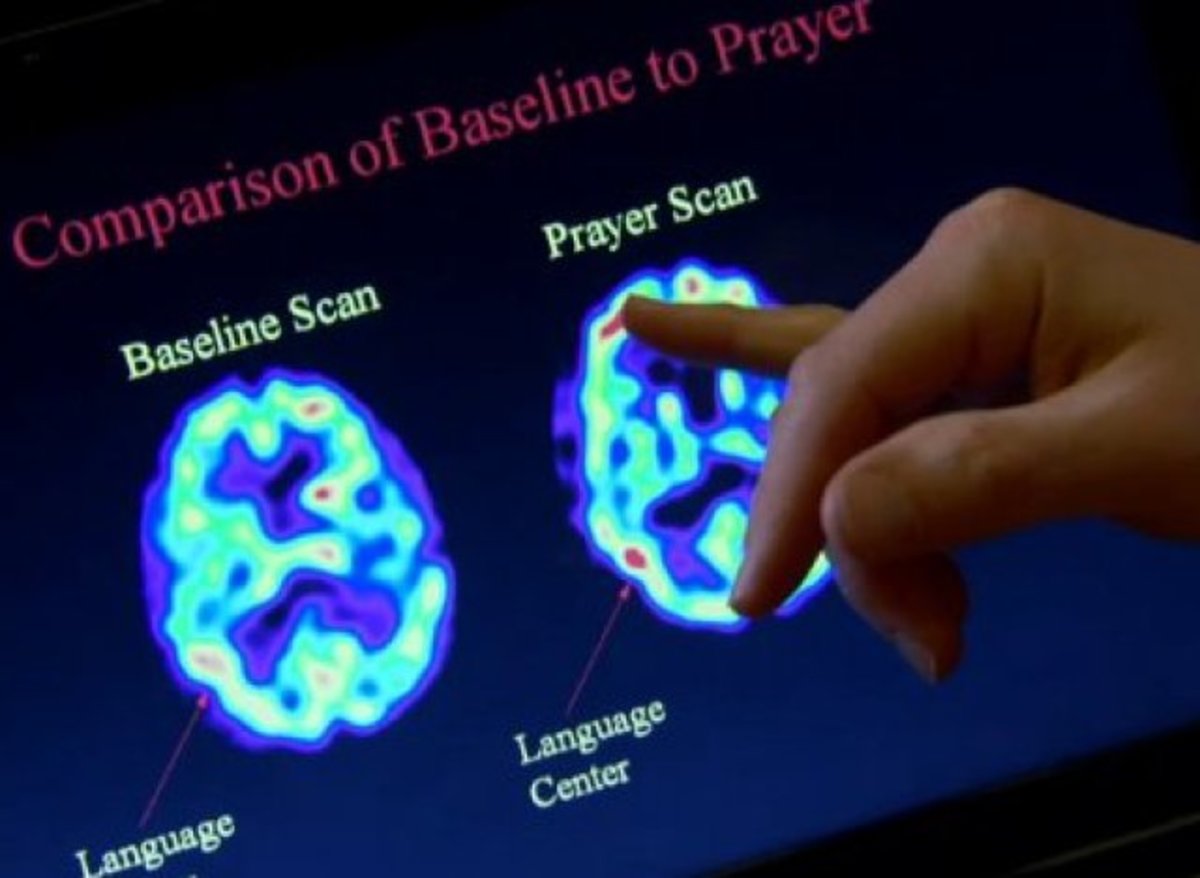Digital Telepathy: Scientists Achieve Brain-to-Brain Communication Across Continents

Imagine being able to speak with a complete stranger nearly 8,000 kilometers away, with out ever opening your mouth, having no visual or physical contact with the other person and in the absence of any form of telecommunications or digital media.
Using non-invasive technology, scientists achieved such a feat in an experiment earlier this year that allowed a participant in India to greet someone in France without ever saying a word or moving a muscle.
Instead they communicated purely through the power of thought.
This achievement has been interpreted by many in the media and general public as a major stride towards the possibility of telepathy. Scientists however have said that the prospect of having full conversations in this manner aren't likely to occur in the near future, and most likely not in our life time.
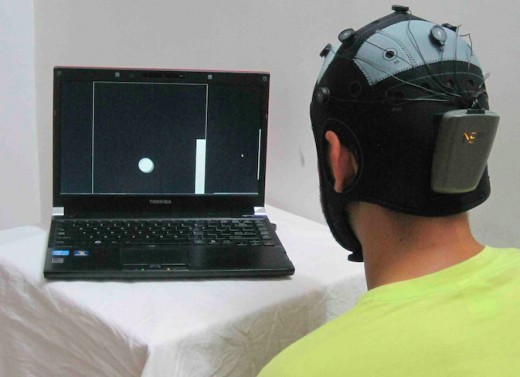
The Experiment
This recent experiment was carried out by an international team of researchers from Starlab Barcelona in Spain, Axilum Robotics in France and Harvard Medical School in North America. It involved the participation of four subjects - one person in India sending the message and three people in France receiving it.
Technology
Testing was made possible through the use of brain-computer interfaces (BCI), an incredible technology that was first described by Dr. Grey Walter in 1964.
BCIs work by reading brain waves and translating them into commands and communication signals, allowing a person to control certain devices, such as computers, machines and even robots, just with their thoughts and intentions and without making any actual physical movement. This technology holds quite a bit of practical potential for people with disabilities to overcome physical limitations that are a result of their condition.
BCIs often rely on invasive or non-invasive methods to record and measure electrical activity in the brain. The most regularly used non-invasive method is known as Electroencephalography (EEG), which has been used largely for diagnostic purposes in cases of epilepsy and other disorders, and involves placing electrodes at targeted areas of the scalp.
Another major technology used by researchers was a robotized transcranial magnetic stimulation (TMS) coil, which is used to treat some forms of depression and other neurological and psychiatric conditions. This method involve stimulating nerve cells within targeted areas of the brain with electromagnetic pulses.
Experiment Method
Experiment goals were realized using internet-linked EEG and TMS technologies.
In Thiruvananthapuram, India the words 'hola' ('hello' in Spanish) and 'ciao' ('hello' and 'goodbye' in Italian) were converted into a binary code of 1s and 0s. The test subject then pictured himself moving his feet when he was shown a 0 and moving his hands when presented with a 1.
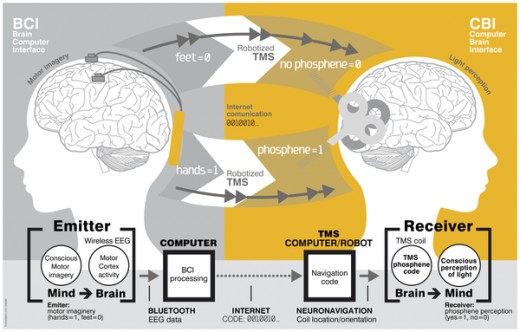
With EEG electrodes placed at strategic parts on the subject's scalp, changes in brain waves based on voluntary motor imagery (i.e. thoughts of moving hands and feet) were recorded and transformed into binary information using BCI technology. The subject was further assisted in the encoding process by a computer display that reacted to brain activity.
This information was then automatically transmitted directly by email to three other test subjects in Strasbourg, France who were interfaced with a TMS coil that would stimulate nerves in the right visual occipital cortex with biphasic pulses, in accordance with the binary code sent from India. If a '1' was received then the subject experienced a phosphene (a perceived flash despite no actual light entering the eye, most commonly encountered when rubbing the eyes while they're closed). If a '0' was received then the subject perceived no flash.
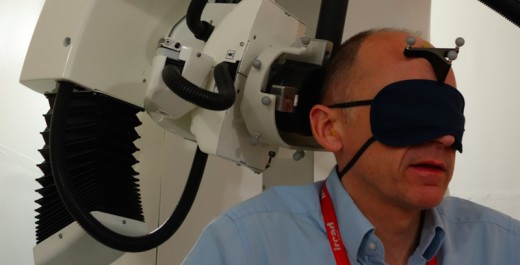
Upon each stimulation, the receiving subject would report whether they experienced a phosphene or not. As each piece of the binary code was received, researchers in France were able to piece the message back together, with the whole process taking around 70 minutes just to send a simple greeting.
How is This Research Useful?
According to co-author Alvaro Pascual-Leone this experiment is "in itself is a remarkable step in human communication, but being able to do so across a distance of thousands of miles is a critically important proof-of-principle for the development of brain-to-brain communications.
"We believe these experiments represent an important first step in exploring the feasibility of complementing or bypassing traditional language-based or motor-based communication.”
Initially it's difficult to imagine what practical purposes this needlessly complicated approach to human communication may have, with it taking over an hour to send a greeting that could have otherwise been expressed in around a second through verbal, physical or written communication.
With further refinement and improvement of the technology and methods, brain-to-brain communication may have a number of medical applications, such as allowing communication from stroke victims or people suffering various diseases or injuries who are otherwise unable to talk. Then there come all the possible advantages of talking directly and privately to another person through our thought or receiving secret information from another's mind, similar to telepaths on TV and film.
"We anticipate that computers in the not-so-distant future will interact directly with the human brain in a fluent manner, supporting both computer- and brain-to-brain communication routinely," explained the report's authors. "The widespread use of human brain-to-brain technologically mediated communication will create novel possibilities for human interrelation with broad social implications that will require new ethical and legislative responses".
Previous Studies on Brain-to-Brain Interfaces
Rat-to-Rat
In 2012 scientists from Duke University managed to achieve a direct brain-to-brain interface (BBI) between two rats, allowing one to influence the behavior of the other.
While the "encoder" rat performed specific tasks in a lever-pulling challenge its brain activity was transmitted directly to a matching cortical area of a second "decoder rat", using intracortical microstimulation (ICMS). This resulted in both rats making similar decisions in the challenge, thanks to the encoder rat sending learned information to the decoder rat.
Monkey-to-Monkey
Much like rats, monkeys have also proven to be compatible with brain-computer interface technology, having in several previous experiments moved robotic arms with the power of their minds.
In February 2014 Harvard Medical School went one better by making it possible for a Rhesus monkey (referred to as "the master") to operate a joystick by controlling the hand of another sedated monkey (called the "avatar") without making any physical contact. The researchers implanted electrodes in both monkeys and used a machine to decode electrical activity from the master monkey's brain into signals that were relayed to the avatar's spine and muscles, allowing control of its hand with a 98% success rate.
Human-to-Rat
In April 2013 researchers accomplished an interspecies brain-to-brain interface between a human and an anesthetized rat. While staring at a computerized strobe light, brain signals from the human (measured with EEG-based BCI technology) were transmitted as a command to a focused ultrasound (FUS) computer-brain interface (CBI) that stimulated an area of the sleeping rat's motor cortex with a beam of acoustic energy. This allowed the human subject to move the rat's tale with a 94% success rate, using only a "thought-process".
Making a Rat's Tail Move with Human Thoughts
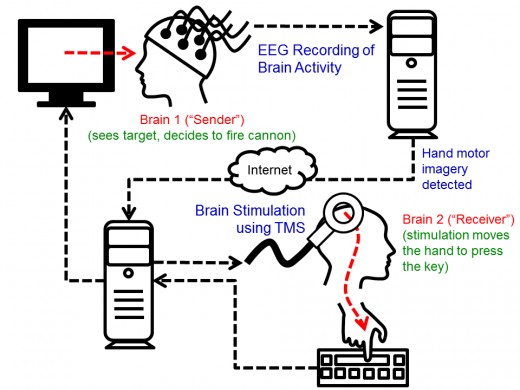
Human-to-Human
While researchers behind this latest study claim that it represents "the realization of the first human brain-to-brain interface" and the "first demonstration of non-invasive direct communication between human minds", this isn't exactly true.
In August 2013 scientists from the University of Washington achieved a similar result when they were able to move the hand of one researcher with brainwave signals from a fellow researcher located in a separate building.
The experiment saw one of the subjects have his electrical brain activity measured with EEG technology and processed and stored with a BCI program as he watched a video game on a computer screen without any input to fire the in-game cannon. When he wanted to fire the cannon, the subject only imagined moving his hand and pressing a touchpad without actually doing so.
The computer recognized this motor imagery signal and transmitted it over the internet to another location on campus, where a TMS coil was positioned above the skull of a second test subject. Upon receiving the signal the TMS device used a rapid changing magnetic field to stimulate the left motor cortex of his brain and involuntarily move his hand, causing him to hit the 'fire button' on the keyboard.

History of Telepathy
Some scholars and media sources have interpreted these latest achievements in brain-to-brain communication as the first step towards some form of digital telepathy.
The ability to pluck information from an other's mind or influence their thoughts and actions is a concept that has been extensively studied since the late 19th century. The term 'telepathy' was coined in 1882 by Frederic W.H. Myers, a French scholar and founder of the Society of Psychical Research (SPR) Frederic. It's derived from the Greek terms tele ("distant") and pathe ("occurrence" or "feeling").
The subject ensnared the interest of some of greatest minds and entrepreneurs in psychology, medicine, science, literature and other eminent individuals of the last 150 years or so. These include biologist Thomas Huxley, authors Vernon Lee and Oscar Wilde, philosophers and psychologists Henry and William James among many others.
Notably, Sigmund Freud, the father of psychoanalysis, had a particular interest in dream telepathy, where a sleeping person receives and transmits thoughts and messages telepathically to another individual. Freud remained unsure and somewhat skeptical as to whether such an ability was possible.

The Soviets referred to telepathy as 'biocommunication' and began their research on the topic in the early 1920s at Leningrad State University's Institute for Brain Research. Though the Soviets were forced to suspend all research for a period under the Stalinist regime, it re-commenced in the 1960s after French magazine,Science et Vie, published a story titled 'The Secrets of the Nautilius' that reported on American telepaths reaching the crew on the first nuclear submarine while it was submerged under the Arctic ice cap.
In the early 1930s psychologists used a card-guessing activity with Zener cards to test telepathic and other psychic abilities. The experimenter would hold a card facing themselves, so that only they know the shape on the card. The test subject would then attempt to use to telepathy to retrieve the information from the experiment's mind and correctly determine the hidden symbol.
Another popular tool to test psychic abilities was the Ganzfield Experiments which began in the mid-1970s. This involves one individual attempting to telepathically communicate to another individual in another soundproof room, who is blindfolded and wears headphones emitting white or pink noise.
In 2006 a U.K scientist, Dr. Rupert Sheldrake, claimed that people are capable of 'telephone telepathy', where people will suddenly think of an acquaintance shortly before that person unexpectedly phones or can guess the identity of a caller before answering the phone. He reported that 45% of the time people were able to correctly guess who was phoning them, though his research has not been well received by his peers.
Before recent research into brain-to-brain interfaces, the potential of anything resembling telepathy has generally been dismissed by the scientific community, who claim that current evidence on humans being naturally capable of telepathic abilities is lacking, flimsy or flawed.
This skepticism from the scientific community though hasn't extinguished the unfaltering belief from supporters that mankind is indeed capable telepathic communication.
Bibliography
- Armstrong, D. 'Researcher controls colleague’s motions in 1st human brain-to-brain interface', UW Today, August 27, 2013.
- Emspak, J. 'Two Rats Communicate Brain to Brain', Discovery News.
- Freud, S. 'Dreams and Telepathy', International Journal of Psycho-analysis, 3, 1922, pp.283-305.
- 'Ganzfeld', The Skeptic's Dictionary (Accessed in October 2014)
- Graimann, B. et al. (eds), Brain–Computer Interfaces, The Frontiers Collection,1 DOI 10.1007/978-3-642-02091-9_1, C Springer-Verlag Berlin Heidelberg 2010
- Grau, C. et al. 'Conscious Brain-to-Brain Communication in Humans Using Non-Invasive Technologies', Plos One, August 2014.
- Greenemeier, L. 'U.S. and Soviet spooks studied paranormal powers to find a Cold War advantage', Scientific American, October 29, 2008.
- Iozzio, C. 'Scientists Prove That Telepathic Communication Is Within Reach', Smithsonian, October 2, 2014.
- LaMothe, J. 'Controlled Offensive Behaviors', U.S Defense Intelligence Agency, 1972.
- Locke, S. 'Brain-to-brain communication is finally possible. It's just very clunky', Vox, September 7 2014.
- Pais-Vieira, M. et al. 'A Brain-to-Brain Interface for Real-Time Sharing of Sensorimotor Information', Nature, Scientific Reports 3, Article number: 1319, February 28 2013
- Choi, C.Q 'Brain Implant Lets One Monkey Control Another', Livescience, February 18, 2014.
- Rao, R.P.N.,A Direct Brain-to-Brain Interface in Humans. University of Washington Computer Science and Engineering, Technical Report No. UW-CSE-14-07-01,
July, 2014
- Saalfield, P. 'Fusing Faculties of the Mind', Harvard Magazine. March-April 2014.
- 'Scientists 'make telepathy breakthrough', BBC, September 6 2014.
- Shanechi M.M., Hu, R.C & Williams, Z.M. 'A cortical–spinal prosthesis for targeted limb movement in paralysed primate avatars', Nature Communications, 5, February 18 2014
- Waltz, E. 'Mind-blowing Advance? Direct Brain-to-Brain Communication Between Humans Demonstrated', IEEE Spectrum. September 4 2014.
- Wheldon, J. 'Telepathy does exists claims Cambridge scientist', Daily Mail, September 5 2006.
- Yoo, S et al. 'Non-Invasive Brain-to-Brain Interface (BBI): Establishing Functional Links between Two Brains', Plos One. April 03, 2013

